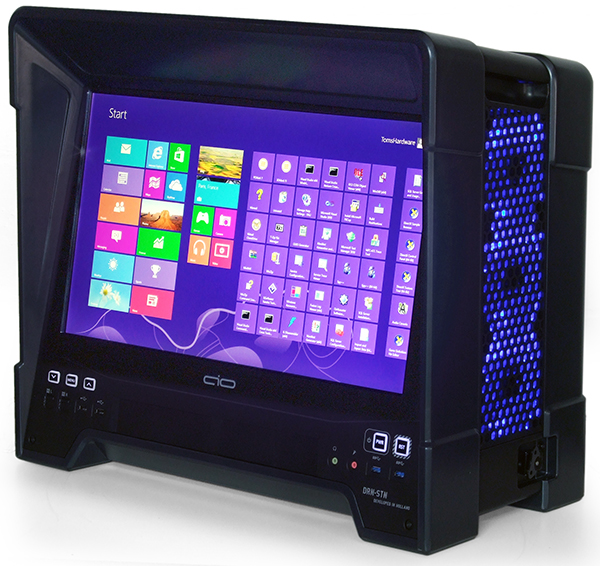AIO DRN-STN Review: A Gaming All-In-One With A 120 Hz Display
The AIO Drone Station is a combination chassis and 120 Hz FHD display, ready to take your choice of ATX motherboard, CPU, graphics cards, storage, and power supply. We'd stop short of calling it portable, but appreciate the appeal of a fast all-in-one PC.
Testing Configuration
AIO Corporation’s DRN-STN sets exemplary standards with its double-walled plastic housing, and even includes a 24” panel that’s high-end by the low-latency standards understood by gamers. On the other hand, 11.2 pounds of steel doesn’t get the company much structure for the internal ATX chassis, and cost cutting can be seen right through to the knock-out-style slot covers. From the performance standpoint, do we even have anything to compare?
Putting aside the display that exists in none of our other cases, triple fans on both sides and dual fans on top put the DRN-STN solidly into our highest range of gaming case comparisons. On the other hand, the internal chassis is a complete low-cost case within a case, and falls within our lowest category of reviewed products. Lacking further direction, I decided to compare it to the top three performers from our recent mainstream gaming case comparison.
| Test System Configuration | |
|---|---|
| CPU | Intel Core i7-3960X (Sandy Bridge-E): 3.3 GHz, Six Cores O/C to 4.25 GHz (34 x 125 MHz) at 1.35 V Core |
| CPU Cooler | Coolink Corator DS 120 mm Tower |
| Motherboard | Asus P9X79 Pro: LGA 2011, Intel X79 Express, Firmware 3501 (03/14/2013) O/C at 125 MHz BCLK |
| RAM | G.Skill F3-17600CL9Q-16GBXLD 16 GB (4 x 4 GB) DDR3-2200 Benchmarked at DDR3-1666 CAS 9 defaults |
| Graphics | Nvidia GeForce GTX 580: 772 MHz GPU, GDDR5-4008 Maximum fan for thermal tests, SLI |
| Hard Drives | Samsung 840 Series MZ-7PD256, 256 GB SSD |
| Sound | Integrated HD Audio |
| Network | Integrated GbE |
| Power | SeaSonic X760 SS-760KM ATX12V v2.3, EPS12V, 80 PLUS Gold |
| Software | |
| OS | Microsoft Windows 8 Pro x64 |
| Graphics | Nvidia GeForce 314.22 |
| Chipset | Intel INF 9.2.3.1020 |
Our hardware was picked long ago for its high heat and noise, but has since been found to keep a better temperature-to-cooling profile than some subsequent parts (such as CPUs based on the Haswell architecture). For the sake of consistency, though, I’m even using the same drive image and graphics drivers, which give me access to several generations of testing.
| Benchmark Configuration | |
|---|---|
| Prime95 v25.8 | 64-bit executable, Small FFTs, 11 threads |
| 3DMark 11 | Version: 1.0.3.0, Extreme Preset: Graphics Test 1, Looped |
| Real Temp 3.40 | Average of maximum core readings at full CPU load |
| Galaxy CM-140 SPL Meter | Tested at 1/2 m, corrected to 1 m (-6 dB), dBA weighting |
But there is a difference in the way the DRN-STN is going to be tested today, and that difference doesn’t show up in the configuration tables. In each of my case round-ups, I place my sound meter at a 45° angle from the front-left corner of the case, except when the case opens from the right. Even then, the 45° measurement is consistent.
Nobody will game on the DRN-STN at a 45° angle because this case has a display that they’ll sit in front of. And that display is on a side that has no vents. That’s equivalent to noise testing a normal case from the closed-off motherboard tray side with a monitor placed between the case and the meter. This advantage is in addition to the case’s built-in double-walled external plastic housing, which also helps.
I make my own rules and I don’t suffer fools concerning case evaluations. Practicality demands that I break my own rules on this one, since anyone using the DRN-STN is positioned differently in respect to case fans. Whether or not that’s fair is an argument of theory versus practice, and I favor practice.
Get Tom's Hardware's best news and in-depth reviews, straight to your inbox.
Current page: Testing Configuration
Prev Page Building With The DRN-STN Next Page Thermal And Acoustic Test Results-
blackmagnum What does this retro looking gaming box have over an established gaming notebook say an Alienware or Asus? Thanks for the choice though.Reply -
Crashman Reply
Up to 20x the graphics power and 2x the CPU performance? I guess it depends on what you plan to do with all that extra space.12698017 said:What does this retro looking gaming box have over an established gaming notebook say an Alienware or Asus? Thanks for the choice though.
I also didn't get a chance to note in the article that "Full Sized" power supply means PS/2 form factor (and extended versions thereof). ATX power standard does not include a form factor, because form factors designate "form". This is, in spite of what Yahoo Answers might tell you. So "Full ATX" is a misnomer concerning power supplies.
-
bloody llama The internal case appears to be made by NZXT. The 3.5" rails and the PCI toolless latch are exactly the same as my NZXT case from 2005.Reply -
Crashman Reply
NZXT doesn't manufacture its own cases though, or at least it didn't in 2005 :)12698206 said:The internal case appears to be made by NZXT. The 3.5" rails and the PCI toolless latch are exactly the same as my NZXT case from 2005.
-
Nossy wow,..$700 for a case, and people are complaining about a $700 video card? WTF are people smoking these days?Reply -
Au_equus Is it oversimplification to say that the system looks like a monitor and a case held together by a shroud? I agree with Trutherizer, especially at that price, but, to go a little bit further, it needs a docking station for a keyboard and mouse.Reply

